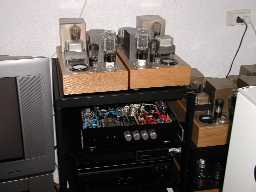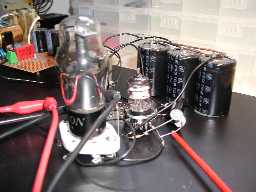
The DDDAC together with Dick van der Merwe's equipment
Updated:
25-Mar-01 15:53
Welcome to the DDDAC 2000 Column!
#2
Well, it took a while..... but here is my second column. I deliberately waited a while, collecting the many inputs I have had from you, the visitors of my Site. Honestly I was surprised to see how many people are actually building and experimenting with a DAC stage. I got lot of tips and other bright ideas. Also interesting discussions (by email) were exchanged. In the meantime the DDDAC is "burned-in" more and more, so I have the final sound from the first version. Next stage is to start tweaking and below I will describe what tweaks and other experiments I am planning to do next.
The most interesting "DIGITAL" tips I received, were to apply small voltage regulators close to each chip to reduce power supply noise and jitter and (the best tip ??) to use totally new (re)-clocking BEFORE the signals go into the DAC chip itself. This look ingenious, as it will be almost impossible to ruin the signal with jitter after this point !!! I will certainly have top try something like this !!
I have noticed (from the reactions per E-Mail and on my site it self) that the service for combined purchasing is not really necessary; most people have their own sources and know where to find parts. NO PROBLEM, even better, it saves me a lot of time.... I will leave this part of the Site open till the end of June. If than comes out that this service is not needed I will remove this section, what is fair to those may be subscribing in the meantime...
What else happened?? I have been visiting the TUBE master of the universe, Dick van de Merwe ( www.triodedick.com ) with the DAC. We have had a very interesting day, listening to the DDDAC, but also to his very well sounding Tube amplifiers. Here it was, I decided to buy immediately a set of AVVT 300B Tubes for my MONO BLOCKS. This caused a major improvement in dynamics and spatial sound... very nice. I was also impressed by the very filigran and clean sound of Dick's amplifiers. The DDDAC Tube stage sounded here sharper and less spatial. I have to say, that this in the meantime (the DDDAC has been playing for a longer time) has become lesser and lesser, but still..... Dick's idea was that this most likely had to do with the capacitors in the Tube stage (not the best you can get...) and the solid state power supply. Reason for one of the below mentioned tweaks / experiments. Dick on his turn, was pleasantly surprised by the audible differences between the different Digital receivers and digital filters.

The DDDAC together with Dick van der
Merwe's equipment
I am very intrigued by the magic of the MU stage. Problem is (in my opinion) that there is little real background on this wonder stage. So a s real engineer, I decide to do some BASIC research. I just build up an experimental stage to be used with all kind of tubes and working points. I shared lots of this information already with Dick, the MU master... He referred to this in his column recently. Unfortunately I am not fully ready yet with the conclusions, so please have some patience, I will share ALL MY findings and backgrounds with you SHORTLY.....


The MU test corner in my Hobby room.
Please note my Digital Scope and FFT Analyzer.
The new activities / tweaks / experiments (random order) I am planning right now is to:
For the Tube Stage, I will build a classic Power supply with Tube rectifiers (I can choose between AZ11, AZ41, GZ34), Pi Filter (solen and MP motor Capacitors and fat Chokes). I will leave the solid State just where it is, so A - B comparison will be easy....... (I tried, but found NOBODY) who has both kinds build in at the same time.... This will be interesting stuff
Replacing all the capacitors in the Tube Stage with Solen MKP and the signal C with Musicap or a paper in Oil signal C.
Do the reclocking trick with D-Flip Flop's for the signals going into the PCM63
Rebuild the DAC stage, but now in 2 sections: Digital receiver Filter, with single TL317's per chip on board and ferrite coils to reduce noise and jitter (??) Second stage will be a switchable section with different DAC CHIPS !! I will take the PCM1704 and a (not know yet) 1 bitter (oh yeaahhh, I wanna proof my self now that I am right with the multi bit DAC chip. I had big discussions and saw lot's of contraversional stuff....) We will find out the truth by doing it this way....
I will rebuild my 300B end amplifiers. This time with separate power supplies for the driver stage (MU ofcourse) and I will experiment with the power supply tube rectifiers and the kind of capacitors. This will be interesting stuff as well
As you see, a loaded program, which will take time, but I promise to share with you all !! No secret stuff on why and how !!!!!
Please be patient and beware with me that this is not my full time hobby, so results will be gradually appear on my site..... just keep checking !!
As always: let me have your reactions and let's use this Site as an platform to further increase our joy on good CD music reproduction!
You can also read previous columns:
Happy Listening and Building !!!!
Doede Douma
IMPORTANT: The information provided on this page is intended as guide for DIY activities and therefore free to copy and or publish. If any one wishes to use any of the information from my WEB site, please make sure to refer and footnote to my URL Link as source! Doede Douma